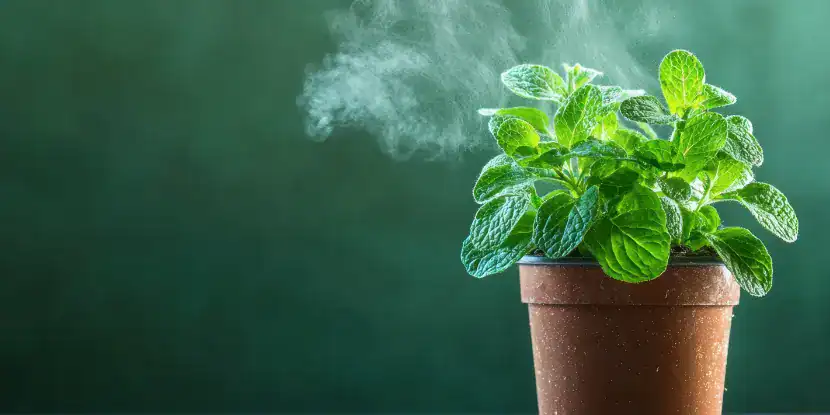People perspire. Plants transpire.
Transpiration is a plant’s cooling process, where it releases water vapor from stomata in its leaves. This natural evaporative cooling moderates plant temperatures and urban heat island effects, especially in densely built areas. For efficient transpiration, a plant needs ample water during extreme heatwaves, or its canopy temperatures can rise above ambient air temperatures.
Many native Southern California plants, like the Matilija poppy, enter dormancy during the hottest months. This adaptation conserves water until cooler, wetter conditions return.
Your ornamental pear tree may struggle, though.

Illustration of the transpiration process.
Evapotranspiration Rates in Summer
Evapotranspiration (ET), the combined water loss through evaporation and transpiration, peaks during Southern California’s summers.
For instance, in July, ET rates can reach approximately 6.51 inches, nearly triple the rates in December, sharply increasing a plant’s water demands.
Leaf Adaptations to Reduce Water Loss
Leaves can have various characteristics that regulate transpiration:
- Small or narrow leaves decrease surface area and limit water loss.
- Waxy or leathery coatings (sclerophyllous leaves) are barriers against evaporation.
- Light-colored or reflective surfaces deflect sunlight and lower heat absorption.
- Hairy leaf surfaces can trap moisture, creating a humid microenvironment.
Anti-Transpirant Sprays
Anti-transpirant sprays coat a plant’s leaves with a thin, protective film, which:
- Slows water loss.
- Prevents sunburn-like symptoms on leaves.
- Strengthens plants against environmental stressors like frost or heat.
Anti-transpirants are safe, biodegradable, and easy to apply, making them a trusted tool for gardeners.

Anti-transpirant sprays can retard water loss and protect against sunburn and frost damage.
Benefits of Anti-Transpirants
- Water Conservation: Anti-transpirants reduce the rate of moisture loss, lowering water needs in drought-prone areas.
- Stress Relief: Plants are vulnerable during drought, extreme heat, or cold. Anti-transpirants protect foliage from sun scorch and frost damage.
- Better Plant Health: Plants remain hydrated and healthy, even during harsh conditions. This helps them recover faster in adverse conditions.
- Mitigated Transplant Shock: Plants moved from one location to another often experience “transplant shock.” Anti-transpirants reduce water loss during transition, helping plants to adjust.
- Improved Root Development: A plant that loses less water can focus more energy on growing strong and deep roots.
Types of Anti-Transpirants
Film-Forming Anti-Transpirants
These create a waxy or resin-like film on the leaves that blocks water loss through the stomata. They’re ideal for temporary protection against extreme weather or during transplanting.
Metabolic Suppressants
These alter the plant’s internal processes to slow hydration loss. They’re often used on specific species or for long-term moisture control.
For most home gardens, film-forming anti-transpirants are the easiest and safest option.

Conserving a plant’s water allows it to focus on root development.
Applying Anti-Transpirants
Timing and method of application make all the difference. Follow these steps for the best results:
1. Pick the Right Product
Choose a product designed for your plants. Some options are best for vegetables, while others are best for flowers, shrubs, or trees.
2. Monitor Weather Conditions
Apply anti-transpirants during calm weather — not too windy or rainy. Extreme weather during or immediately after application can limit their effectiveness.
3. Dilute & Mix Properly
Most products require mixing with water before spraying. Follow the manufacturer’s instructions and use a clean garden sprayer for an even application.

Stomata in a plant leaf.
4. Spray Evenly
Coat the leaves evenly, including the undersides where stomata are concentrated. Avoid oversaturating the leaves.
5. Repeat Applications
You may need to reapply every 2–4 weeks. A single, well-timed application may suffice for seasonal protection (e.g., frost).
6. Avoid Overuse
Plants need some degree of transpiration for photosynthesis and nutrient transport. Don’t go nuts with the transpirants.
When to Use Anti-Transpirants
- During Drought: Anti-transpirants help plants retain moisture longer when water access is limited.
- Before Frost: A single application before a frost can shield leaves from ice damage.
- After Transplanting: To ease transplant shock in trees, vegetables, or ornamental plants, apply anti-transpirants immediately after moving them.
- Before Traveling: Going on vacation? Use anti-transpirants to control plant hydration loss while you’re gone.

Transpiration in a houseplant.
FAQs About Anti-Transpirants
Q: Are anti-transpirants safe for all plants?
Anti-transpirants are safe for most plants, but always check product labels to ensure compatibility with specific species.
Q: How often should I apply anti-transpirants?
Most products recommend reapplication every 2–4 weeks or after high rainfalls.
Q: Can I use anti-transpirants indoors?
Anti-transpirants can be used sparingly indoors for large potted plants struggling with hydration.
Q: Do anti-transpirants affect photosynthesis?
Some metabolic suppressants can slightly reduce photosynthesis, but film-forming anti-transpirants don’t if applied correctly.
Q: When is the best time of day to apply anti-transpirants?
Apply them early in the morning or late afternoon to avoid the midday heat and give the spray time to dry evenly.
Q: Are anti-transpirants environmentally friendly?
Most modern formulations are biodegradable and pose no danger to the environment.
Q: Can anti-transpirants replace regular watering?
Anti-transpirants aren’t a replacement for watering. They’re a supplementary tool to help plants retain moisture — not a substitute for hydration.
Q: Where can I buy anti-transpirants?
You can find anti-transpirants at Anawalt Lumber and local gardening stores, online marketplaces, or specialized retailers that promote drought-resistant gardening.

